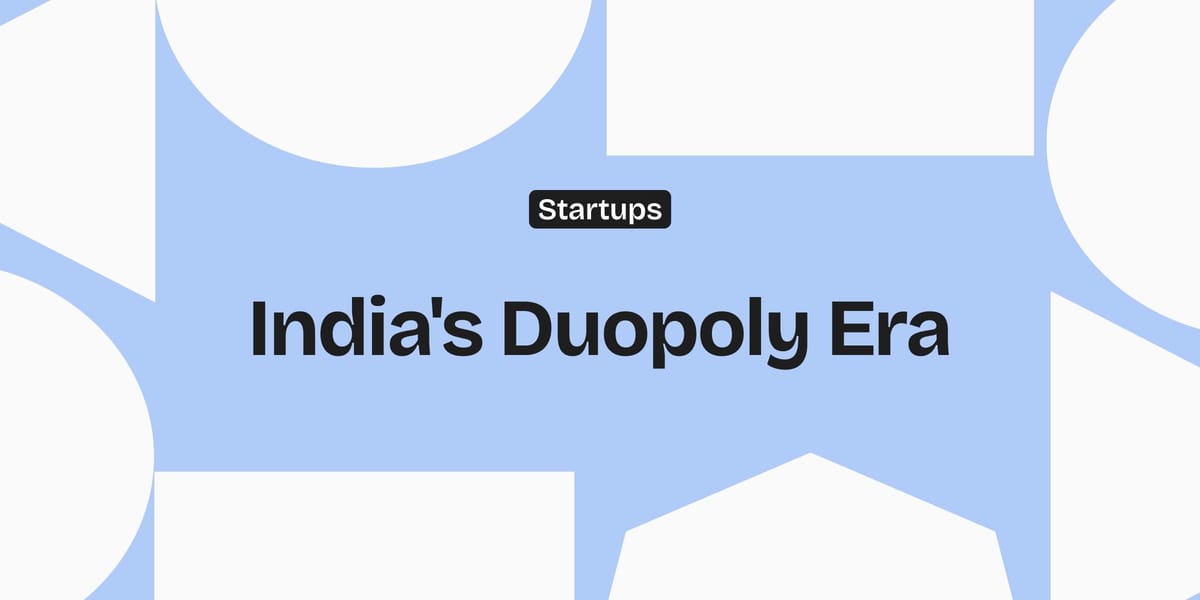Living in a Two Player World
Across India’s biggest markets, two dominant names hold the top, and everyone else fights for scraps. It is efficient, but it raises questions about the future.

Look at almost any major consumer market in India and you will see the same structure. Two brands dominate, leaving little space for a third to thrive. Telecom is Jio and Airtel. Food delivery is Zomato and Swiggy. E commerce is Flipkart and Amazon. Airlines are IndiGo and Air India. Retail supermarkets are Reliance and DMart.
A duopoly is when two companies control almost the entire market. It is not technically a monopoly, but for consumers the choices can feel just as narrow. You are not deciding between a wide range of possibilities. You are picking between two familiar names.
Duopolies emerge in markets where scale is everything. Infrastructure heavy industries like telecom, airlines, retail, and delivery services require huge capital investments. Once a company builds nationwide distribution or a large operational network, it gains a structural advantage that is hard to challenge. Add brand recognition and consumer trust, and new entrants face a steep climb.
One of the clearest signs that a duopoly is taking shape is competitor exit. Smaller players disappear, either shutting down quietly or pivoting to something else. It is rarely sudden. It happens slowly as acquiring customers becomes too expensive, suppliers focus on the big two, and investors withdraw support.
Recent history shows it clearly:
- Vodafone Idea's decline as Jio and Airtel pulled ahead.
- Smaller food delivery platforms closing as Zomato and Swiggy consolidated their networks.
- Local taxi apps fading away as Ola and Uber strengthened their grip.
Duopolies are not always bad. For the companies involved, fewer competitors mean more predictable revenue, better pricing control, and the ability to plan long term. For consumers, the early stages of a duopoly can bring better prices, improved services, and rapid infrastructure growth. Jio's entry into telecom in 2016 lowered data prices across the country. Zomato and Swiggy's rivalry brought faster deliveries and expanded food options into smaller towns. Flipkart and Amazon have made next day delivery routine in metro areas.
When only two companies dominate, service standards often improve. Payment systems, refund policies, and customer support processes become more consistent.
The challenge comes later. Once the battle for market share cools, the focus shifts from winning customers to maximising revenue from the ones already on board. This is when delivery fees begin to rise, surge pricing becomes normal, and loyalty benefits start to shrink. Innovation slows, with companies opting for safer incremental changes rather than bold new moves.
For new entrants, the barrier is enormous. Competing means not just creating a better product, but building an entire ecosystem from scratch, while the established players already have scale, brand loyalty, and deep data on customer behaviour.
This structure also affects what ideas even get funded. Investors often avoid backing a challenger unless it has a clear plan to displace one of the two leaders. Good ideas can die early simply because the market is seen as closed.
The long term effects of duopolies are worth thinking about. They can bring stability and quality, but they also risk making markets predictable and slow to evolve. The next wave of disruption in India is unlikely to come from directly challenging the leaders in these entrenched sectors. It will more likely come from creating entirely new categories where no one has yet built an advantage.
Until then, these two player markets will continue to shape how we shop, travel, communicate, and eat. The choice will appear to be ours, but often, it will already have been narrowed for us.